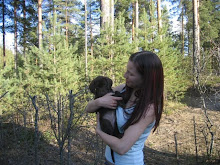
Dogs gain practical information about the social and physical environment through the consequences of their behavior so they can control and manipulate significant events vital to their interests. Animal behaviorism defines reinforcements ans punishments as follows:
Reinforcement (R) increases the relative probability of the behavior it follows.
Punishment (P) decreases the relative probability of the behavior it follows.
So dog decides what is reinforcement or punishment, and what is not. We can only observe the dog and its gesture and behavior. It is also good to decide and know what kind of behavior you want before you start training, because reinforcement will affect to dog´s behavior. Example food is calming reinforcement to the most of the dogs, but playing with toys is exciting.
Reinforcers and punishers can be divided to positive (+) and negative (-):
Positive reinforcement (R+) occurs when dogs behavior is strengthened by producing or prolonging some desirable consequence.
Negative reinforcement (R-) occurs when dogs behavior is strengthened by reducing or avoiding some undesirable consequence.
Negative punishment (P-) occurs when dogs behavior is weakened by omitting the presentation of the reinforcing consequence.
Positive punishment (P+) occurs when animals behavior is weakened by presenting the previosly escaped or avoided consequence.
Positive punishment involves lots of risks and disadvantages. It is associated with the elicitation of various concomitant emotional states, especially frustration, anxiety and fear. Punishment usually makes dog to fear something that is present in the training session. Its very likely that dog´s fear is directed to the owner, because she/he is always present. Classical conditioning occurs.
In dog training, using both positive reinforcement and positive punishment has lots of disadvantages. First of all, the power of rewards weakens. Secondly, withdrawal of reward (negative punishment) isn´t so good tool in dog training anymore. It is very powerfull to "tell" to the dog when it is doing something wrong by withdrawing reward. Punishment doesnt also tell dog what to do. Its important to remember that severe punishment causes severe risks and disadvantages. Altough we wouldnt think the ethical side of punishment, there´s still lots of good reasons not use positive punishments. When we reinforce dog´s behavior, it becomes entrepreneurial. But using positive punishments in dog training could lead to dog´s passivity, it starts to avoid the things that could lead to punishment. And if punishment has been unpredictable and uncontrollable in dog´s perspective - dog is never quite sure when punishment is going to come, and never quite sure why it is administered - it can start to avoid all activity. In that case dog´s training is nearly impossible or at least very slow, because we have to use lot of time to get some action in dog. Positive reinforcement satisfy some psychological and physiological need. For example, when dog is hungry and it learns that sitting leads to food, after several positive experiences (sitting-->food) the probability that the dog will sit on cue is increased. Trough this simple lesson, the dog not only learns how to sit, but, more importantly, the dog learns that its action can control the environment. And that is a outcome that makes learning itself intrinsically rewarding. Reinforcement also exhibits many irregular and, perhaps, unanticipated characteristics. For example, while the opportunity to eat represents a very strong reinforcer for a hungry dog, the dog may also find just smelling the food reinforcing.
When we look reinforcers and punishers in dog training, it is good to remember that the provision of anything that the dog would rather be doing at any given moment may function as a reward. And on the other hand, anything that the dog would rather not be doing at any given moment might be used as a punisher. During the training process, dogs form certain expectations and predictions about outcomes associated with their behavior. So if a dog receives a reward that is significantly smaller than expected, the outcome is perceived as punitive (and disappointing), resulting in the trial rendering the response weaker. So I repeat myself: dog decides what is reinforcement or punishment, and what is not.
Timing and repetition play very important role in dog training. For a reinforcer to be effective, it must closely follow the target behavior and optimally, the reinforcer should be presented immediately after the target behavior is emmitted. Dog only learns if the consequences of its behavior follows relatively fast. Using only unconditioned reinforcer (example food and toys), particularly teaching new things to the dog, reinforcing can be difficult. Clicker trainers use clicker as a conditioned reinforcer, but it could be any kind of stimulus. Conditioned reinforcer is needed only when we want to reinforce very precisely, in second ot two. But teaching dog long-lasting activities, example to "stay", it is not usefull anymore.
When using reinforcement in dog training, it is important to remember chedule them right. During the early stages of training, a new behavior is reinforced every time it occurs and once a stable operant level is obtained, dog´s behavior is usually brought under the control of an intermittent schedule of reinforcement. For example when you are teaching your dog to "follow", intermittent reinforcement makes the behavior more resistant to extinction. Dog never knows when the reward is presented to it and it maintains good performance through the hole exercise.


No comments:
Post a Comment